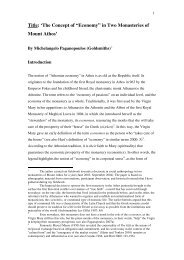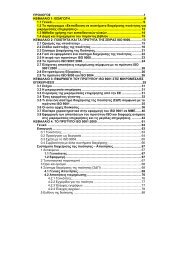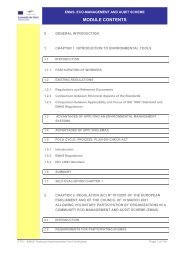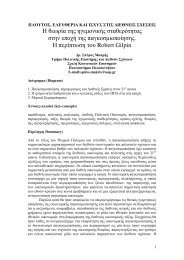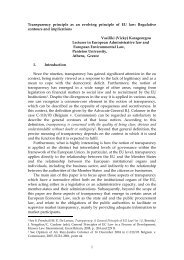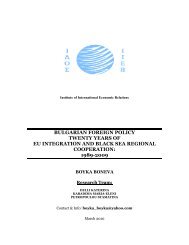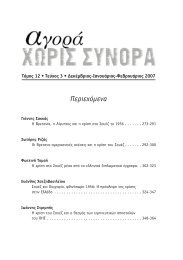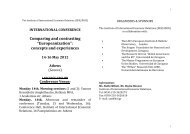Regionalism from
Regionalism from
Regionalism from
Create successful ePaper yourself
Turn your PDF publications into a flip-book with our unique Google optimized e-Paper software.
sae@hol.gr<br />
REGIONALISM – INTER-<br />
REGIONALISM AND<br />
BIREGIONALISM<br />
Charalambos Tsardanidis<br />
Director of the Institute of<br />
International Economic Relations
REGIONALISM<br />
• Definition : <strong>Regionalism</strong> can be<br />
defined as cooperation among<br />
governments or non governments<br />
organizations in three or more<br />
geographically proximate and<br />
interdependent countries for the<br />
pursuit of mutual gain in one or<br />
more issue-areas
THE FEATURES OF NEW REGIONALISM<br />
• Megarionalism<br />
• Great powers<br />
participation<br />
• Encompasses<br />
both developedunderdeveloped<br />
countries<br />
• Open<br />
<strong>Regionalism</strong><br />
• Variation in<br />
institutionalisation<br />
• No dividing line<br />
between<br />
political and<br />
economic<br />
regionalism<br />
• <strong>Regionalism</strong><br />
<strong>from</strong> ‘below’<br />
• Overlapping<br />
membership
SUB-REGIONALISM<br />
•Subregionalism emerge within very<br />
large macro-regions, such as<br />
Europe, and may facilitate<br />
cooperation among a grouping of<br />
states that have particular interests<br />
and problems in common. Subregionalism<br />
should be considered<br />
as an integral part of the evolution<br />
of the continental regionalization<br />
process
INTER-REGIONALISM<br />
•Relations between regional<br />
groupings with more or less<br />
regular meetings centering on<br />
exchanges of information and<br />
cooperation in specific policy<br />
fields based usually on a low<br />
level of institutionalization
FORMS OF INTERREGIONALISM<br />
• Intergovernmental inter-regionalism<br />
• Transregionalism Transregionalism, refers<br />
in a general way to relations between<br />
regions, and these relations may differ in<br />
terms of comprehensiveness .<br />
‣ Transregionalism <strong>from</strong> Below<br />
(transnational)<br />
‣ Comprehensive Transregionalism<br />
• Asymmetrical Interregionalism<br />
• Hybrid interregionalism
INTERGOVERN-<br />
MENTAL INTER-<br />
REGIONALISM<br />
Comprehensive Regional<br />
Cooperation<br />
Schemes/Organisation<br />
Comprehensive Cooperation<br />
Regional<br />
Scheme/Organisation
TRANS-<br />
REGIONALISM<br />
Comprehensive<br />
International Region<br />
Comprehensive International<br />
Region
COMPREHESIVE<br />
TRANS-<br />
REGIONALISM<br />
Comprehensive<br />
International Region<br />
Comprehensive International<br />
Region
ΑSYMMETRICAL<br />
INTER-<br />
REGIONALISM<br />
International Region<br />
International Region
FORMS OF HYBRID<br />
INTER-REGIONALISM<br />
• Relations between regional groupings<br />
and single state<br />
• Relationship between a formal regional<br />
group and a “constructed” regional<br />
group<br />
• The creation of institutional<br />
arrangement between major<br />
representatives of two or more regions<br />
which claim regional leadership
REGIONALISM –<br />
SINGLE POWER<br />
RELATIONSHIP<br />
Comprehensive<br />
International Region<br />
State
HYBRID<br />
CONSTRUCTED INTER-<br />
REGIONALISM<br />
International Region<br />
“ Constructed” Region<br />
(IBSA)
HYBRID INTER-REGIONALISM<br />
WITH LEADER STATES FROM<br />
DIFFERENT REGIONS (BISA)<br />
BRAZIL<br />
INDIA<br />
SOUTH AFRICA
BI -REGIONALISM<br />
• Relations between regional<br />
grouping organizations which<br />
we could call bilateral<br />
interegionalism /biregionalism<br />
EU- ASEAN / EU – Mercosur/<br />
ASEM, FEALAC / EU- CELAC
EU- CELAC : WHAT KIND OF<br />
INTER-REGIONALISM<br />
•Intergovermental interregionalism?<br />
•Transregionalism? Or<br />
•Comprehensive<br />
transregionalism?
A COMPARATIVE ANALYSIS OF EU-<br />
CELAC: CRITERIA<br />
• Main characteristics<br />
• Institutionalism<br />
• Managing interdependence and global<br />
governance<br />
• Contributing to regional identity formation<br />
• Balancing superior power<br />
• Provider of security<br />
• Strengthening the balancing power of both<br />
regions
COMPRATIVE ANALYSIS OF INTER-<br />
CRITERIA<br />
• Characteristics<br />
• Institutionalism<br />
• Managing<br />
interdependence<br />
and global governance<br />
• Regional identity<br />
formation<br />
• Balancing superior power<br />
• Provider of security<br />
Strengthening<br />
• The balancing power<br />
of both regions<br />
INTERNATIONAL<br />
SYSTEM<br />
REGIONALISM<br />
BI-REGION-<br />
ALISM<br />
Similarities<br />
Differences<br />
ASEM<br />
FEALAC<br />
EU -CELAC



